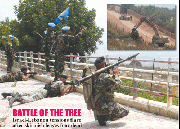
|
| Lebanese soldiers take up position as U.N peacekeepers (in blue berets) gesture towards Israeli soldiers while asking them to stop cutting trees at the Lebanese-Israeli border in Adaisseh village, southern Lebanon August 3, 2010. (Inset) An Israeli crane supported by an armed Israeli vehicle prunes a tree on the Lebanese side of the border prior to clashes between the two sides that left two Lebanese soldiers, one Lebanese journalist and an Israeli lieutenant-colonel dead. REUTERS |
The streets of the Lebanese village of Adaysseh were nearly deserted on Wednesday, a day after a deadly battle between Lebanese soldiers and Israeli troops cutting trees along the nearby border.
But soldiers could be seen on some of the rooftops in Adaysseh, which lies just north of the border and overlooks the site where fighting killed two Lebanese soldiers and a journalist, as well as an Israeli officer.
Adaysseh is home to about 3,000 Lebanese people, and many of its inhabitants make their living from farming, particularly tobacco growing.
It is in a region largely controlled by Hizbullah, the Shi’a movement that fought a devastating war with Israel four summers ago.
The village square was the scene of a fierce battle during the 2006 war, and many houses were shelled at the time.
With the memories of 2006 still vivid, most of the residents fled on Tuesday when the clashes broke out, fearing an escalation.
Tension remained high in the border area, especially where the clashes took place, and there was a heavy deployment of Lebanese troops and UN peacekeepers, whose tanks were patrolling the area.
But some residents could be seen returning cautiously on Wednesday. Passengers on board vehicles heading to the village could be seen waving Lebanese flags.
Lebanon’s army chief, General Jean Kahwaji, was greeted with applause by residents as he briefly visited an army post partly destroyed by Israeli shelling on Tuesday.
The post is located on the northern edge of the village and overlooks the border area where the controversial trees that sparked the fighting are located.
Residents placed flowers on the rubble in memory of the two soldiers and the journalist killed.
A two-story building adjoining the army post, where soldiers had sought refuge during the shelling, was also hit by a shell and partially destroyed.
A small shop on the ground floor was heavily damaged.
“All those who have families and children fled the village they are cautiously coming back as things seem to have calmed down,” said Khadijeh, 55.
She spoke to AFP near the village as she returned home in a taxi, with her three children and belongings.
Another resident, 30-year-old Hussein Sabagh, said “the situation seems back to normal, and residents are relieved. I stayed on yesterday to help the army in case of need. We are proud of them.”
Jalal Rammal, 38, said he was passing by the Lebanese army post when it was shelled.
“I was hit by shrapnel in the leg and found myself lying on the ground near a soldier who was unconscious,” he said.
Each side blamed the other for sparking Tuesday’s firefight.
Israel said its troops were fired upon while conducting maintenance work along the border, and that UN forces had been notified in advance. Lebanon said its troops opened fire after an Israeli patrol crossed the border fence.






Leave a Reply